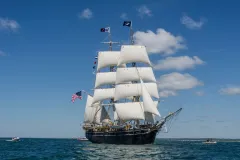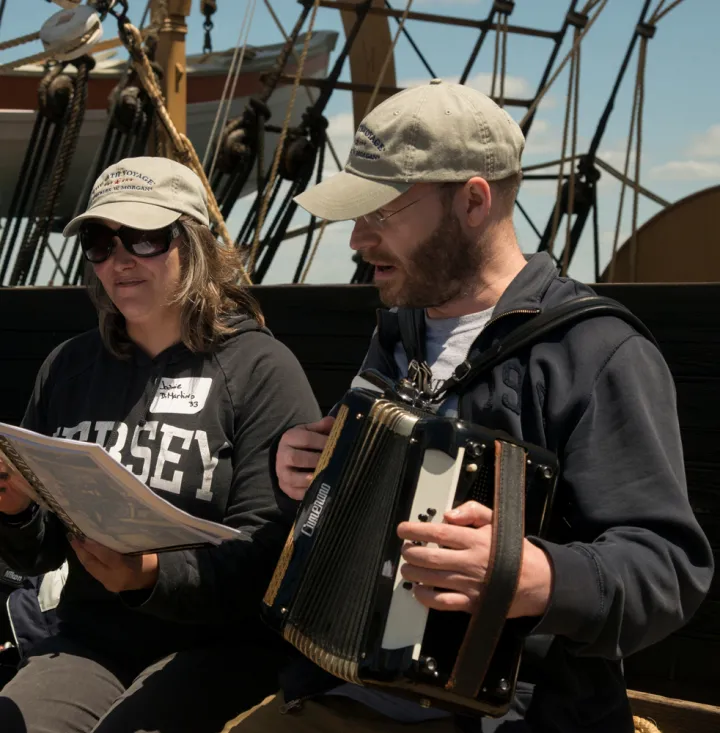History and Modern Science Collide for the 38th Voyage of the Charles W. Morgan

Traveling aboard the Charles W. Morgan, a 173-year-old whaling ship on its 38th Voyage, I’m struck by its paradox: this vessel which spent years chasing and killing whales is now helping us to study these magnificent creatures.
This summer's voyage is an unusual one. Along with the scientific research done onboard, I’m also coordinating a cohort of artists and scholars selected as 38th Voyagers, who will sail for a day out of Provincetown, Massachusetts into Stellwagen Bank National Marine Sanctuary in mid-July. The 38th Voyagers are researchers from a variety of disciplines including artists, musicians, scientists, journalists, teachers, scholars, and whaler descendants. They will take part in a public-history project, each producing a work of research reflecting their time aboard the Morgan.
I sailed aboard the vessel earlier this summer to test the scientific gear we will be using throughout the voyage. The basic instruments I’d assembled to make a weather station functioned surprisingly well—sometimes simpler is better. During the brief pauses while we tacked—turned our bow through the wind and waited for the sails to fill—I tossed a bucket overboard to bring back a water sample. With the help of some idle hands, I collected some oceanographic data from those samples: temperature, salinity, nutrients, and chlorophyll levels. On one of the tacks, we successfully trailed a fine-meshed net (each hole only 0.02 millimeters) through the water alongside the ship for several minutes to collect phytoplankton. Later, back at our lab in Mystic, my students looked at the sample under a microscope to check if we’d collected any toxic algae (we hadn’t).
Like generations of sailors before us, including the whalers who used the ship, someone onboard will make basic observations about the weather and birds and mammals sighted along the way. A whaling vessel would not typically carry a scientist, but basic observations about the ocean conditions were paramount to both safety and to finding whales at sea. We know this from old ship’s logs and writers, like Herman Melville, who told stories of whaling, biology, and sailing. In Moby-Dick, Melville noted in chapters such as “The Chart” that the migrations of whales could be tracked by closely observing currents, fish and birds.
While 19th-century instruments may have been made with different materials than those we brought on the Morgan’s 38th Voyage, their scientific validity remains. In 1832 Charles Darwin turned some cloth into a plankton net, which he towed from the Beagle to study algae blooms near the Canary Islands. Around the time of the Morgan’s first voyage, the father of oceanography, Lt. Matthew Fontaine Maury, Superintendent of the U.S. Naval Observatory (1842-1861), began recommending mercury thermometers be used regularly at sea. Maury developed a systematic method of recording oceanographic data, which included air and water temperature, barometric pressure, wind, and position–all measurements we are making aboard the Morgan in 2014. Sure, we’ll have a GPS location for each observation we make out at sea on the 38th Voyage, but the process of gathering information and compiling it in a book is very much a traditional endeavor.
Some of the 38th Voyagers are interested in mapping ocean currents with GPS-enabled drifters, a modern version of the message in a bottle. Others are poets hoping to capture the essence of what it means to sail on a whaling ship in 2014, musicians eager to have a firsthand connection to the cultural exchanges that were fostered during distant voyages, and literary historians documenting the changing perceptions of whales from Melville to Raffi. We are all collecting data: the scientist with a bucket, artist with charcoal, the journalist with a notepad.
My observations and those of my fellow 38th Voyagers will make the Morgan’s 38th Voyage its most recorded journey yet. This will continue the Charles W. Morgan's tradition of being one of the most documented ships in U.S. history while bringing more vital information about whales to the history books.


